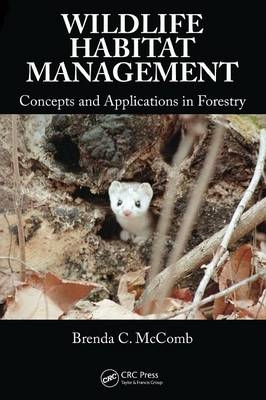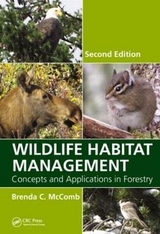
Wildlife Habitat Management
Crc Press Inc (Verlag)
978-0-8493-7489-0 (ISBN)
- Titel erscheint in neuer Auflage
- Artikel merken
In recent years, conflicts between ecological conservation and economic growth forced a reassessment of the motivations and goals of wildlife and forestry management. Focus shifted from game and commodity management to biodiversity conservation and ecological forestry. Previously separate fields such as forestry, biology, botany, and zoology merged into a common framework known as conservation biology and resource professionals began to approach natural resource problems in an interdisciplinary light. Wildlife Habitat Management: Concepts and Applications in Forestry presents anintegrated reference combining silvicultural and forest planning principles with principles of habitat ecology and conservation biology. With extensive references and case studies drawn from real situations, this book begins with general concepts such as habitat selection, forest composition, influences on habitat patterns, and the dynamics of disturbance ecology. It considers management approaches for specific habitats including even-aged and uneven-aged systems, riparian areas, and dead wood and highlights those approaches that will conserve and manage biodiversity. The author discusses assessment and prioritization policies, monitoring techniques, and ethical and legal issues that can have worldwide impact. Detailed appendices provide a glossary, scientific names, and tools for measuring and interpreting habitat elements. Writing in a species-specific manner, the author emphasizes the need to consider the potential effects of management decisions on biodiversity conservation and maintains a holistic approach throughout the book.
Drawing from the author’s more than 30 years working and teaching in natural resources conservation, Wildlife Habitat Management: Concepts and Applications in Forestry provides a synopsis of current preservation techniques and establishes a common body of knowledge from which to approach the conservation of biodiversity in the future.
University of Massachusetts, Amherst, USA
Introduction
What is Habitat?
Habitat Function
Habitat for Humans
Forests as Habitat
Historical Approaches to Managing Forests as Habitat
Why Manage Habitat?
Case Study: The Forests of British Columbia
Vertebrate Habitat Selection
Hierarchical Selection
Density-Dependent Habitat Selection
Relationship between Habitat Quality and Demographics
Population Fitness
Measuring Habitat Selection
Proximate and Ultimate Cues to Habitat Quality
Case Study: American Marten Habitat Selection
Forest Structure and Composition
Food and Cover in a Cellulose-Managed System
Vertical Complexity
Horizontal Patchiness
Forage Availability and Quality
Fruit Production
Dead and Damaged Trees
Tree Species and Invertebrate Associations
Tree Size and Density
Forest Floor Litter and Soil
Proximity to Water
Case Study: Plant Response to Herbivores, or Its a (Chemical) War out There!
Physical and Cultural Influences on Habitat Patterns
The Physical Environment
Geology
Topography: Slope, Aspect, and Elevation
Soils
Climate
Hydrology
Vegetation Patterns
Cultural Effects on Habitat Patterns
Land Use
Climate Change
Invasive Species
Case Study: Passenger Pigeons, Humans, and Forests
Disturbance Ecology and Habitat Dynamics
Disturbance Size
Disturbance Severity
Disturbance Frequency
Disturbance Frequency, Size, and Severity Relationships
Stand Dynamics
Stand Initiation
Stem Exclusion
Understory Reinitiation
Old Growth
Succession as a Continuum of Habitat Elements
Successional Pathways
Management Implications from Disturbances
Silviculture and Habitat Management: Even-Aged Systems
Silviculture as a Forest Disturbance
Characteristics of Even-Aged Stands
Considering the Capabilities of the Site
Choosing a Regeneration Method
Identifying Legacy Elements to Retain
Site Preparation Effects on Habitat Elements
Natural Regeneration and Planting Options
Vegetation Management Effects on Habitat Elements
Precommercial Thinning
Commercial Thinning
Fertilization
Rotation Length: Ecological and Economic Trade-Offs
Case Study: Douglas-Fir Plantation
Silviculture and Habitat Management: Uneven-Aged Systems
Characteristics of Uneven-Aged Stands
Considering the Site Potential
Uneven-Aged Regeneration Methods
Natural Regeneration and Planting Options
Uneven-Aged Stand Development
Habitat Elements in Uneven-Aged Stands
Vertical Structure
Horizontal Diversity
Forage and Browse
Dead and Dying Trees
Mast
Challenges to Using Uneven-Aged Methods
Nontraditional Management Approaches
Case Study: Managing a Small Privately Owned Forest
Desired Future Conditions
Developing the Stand Prescription
Case Study: Growing Red-Cockaded Woodpecker Habitat
Species Background and Management Options
Current Stand Condition
Desired Future Condition
Management Actions to Achieve the Desired Future Condition
Monitoring Plans
Budget
Riparian Area Management
Animal Associations with Riparian Areas
Gradients within Riparian Zones
Riparian Functions
Riparian Buffers
Managing within Streamside Management Areas
Beavers—The Stream Managers?
Case Study: Riparian Area Management in a Patchwork Ownership
Dead Wood Management
Primary Cavity Excavators
Secondary Cavity Users
Log Users
Patterns of Dead Wood Following Disturbance
Changes in Dead Wood over Time
Dead Wood during Stand Development
Management of Tree Cavities and Dead Wood
Live Cavity-Tree Management in Managed Stands
Dead Wood Retention and Harvest System Considerations
Creating Snags and Logs for Wildlife
Monitoring Cavity Trees, Snags, and Logs
Case Study: Managing Dead Wood in Oregon Forests
Landscape Structure and Composition
Defining the Landscape
Habitat Quality at the Landscape Scale
Living on the Edge
Edge Geometry
Habitat Fragmentation
Habitat Area: Species–Area Relationships
Case Study: Habitat Area or Pattern?
Landscape Connections
Dispersal
Understanding the Probability of Successful Dispersal
Connectivity and Gap-Crossing Ability
Management Approaches to Connectivity
Case Study: Matrix Management for a Wide-Ranging Species
Approaches to Biodiversity Conservation
What is Biodiversity?
Setting Biodiversity Goals
How Do We Conceptualize “Biodiversity” to be Able to Conserve It?
Coarse-Filter Approaches
Meso-filter Approaches
Fine-Filter Approaches
Challenges to Managing Biodiversity
Spatial Scale
Time
Uncertainty
Landscape Management Plans
Establishing Goals
Current Conditions
Desired Future Conditions
Pathways to DFCs
Developing the Landscape Management Plan
Policy Guidelines for HCPs
General Structure of the Landscape Management Plan
Considering Alternative Plans
Finding Solutions to Land Management Planning Problems
Plan Effectiveness
Ecoregional Assessments and Prioritization
Ecoregional Assessments
Examples of Ecoregional Assessments
Conducting an Ecoregional Analysis
Assessing Patterns of Habitat Availability and Quality
Prioritizing Management and Assessing Policies
Coarse-Filter Approach
Integrated Coarse- and Fine-Filter Approaches
Fine-Filter Approaches
Utility and Effectiveness of Ecoregional Assessments
Viable Populations in Dynamic Forests
Extinction Risks
Goals of PVAs
PVA Models
Conducting a PVA for a Forest-Associated Species
Examples of PVA Analyses
Grizzly Bear
Marbled Murrelet
Northern Spotted Owl
Model Errors and Uncertainties
Poor Data
Difficulties in Parameter Estimation
Weak Ability to Validate Models
Effects of Alternative Model Structures
Interpreting Results from PVA Projections
Monitoring Habitat Elements and Populations
Adaptive Management
Designing Monitoring Plans
Selection of Response Variables
Describe the Scope of Inference
Describe the Experimental Design
Sampling Intensity, Frequency, and Duration
Monitoring Habitat Elements
Monitoring for Species Occurrence
Monitoring Trends
Cause-and-Effect Monitoring Designs
Are Data Already Available and Sufficient?
Making Decisions with Data
Examples of Approaches to Monitoring
Monitoring Clonal Plants
Monitoring the Occurrence of a Small-Mammal Species
Monitoring Trends in a Salamander Subpopulation
Monitoring Response of Neotropical Migrant Birds to Forest Management
Monitoring Habitat Elements
Forest Sustainability and Habitat Management
Defining the Resources to be Sustained
Scales of Sustainability
Humans are Part of the System
Forest Certification
Effectiveness of Certification
Regulatory and Legal Considerations
International Laws and Agreements
National Laws
State Laws
Municipal Policies
Policy Analysis
How Decisions in the United States Influence Habitat in the World?
Should I Manage a Forest?
What Does Restoration Mean?
Human Requirements as Constraints on Goals
Developing a Personal Management Philosophy
Our Place on Earth
Living Simply and Sustainably
Leaving the World a Better Place
Appendix 1: Common and Scientific Names of Species Mentioned in the Text
Mammals
Birds
Amphibians
Reptiles
Insects
Fish
Plants
Appendix 2: Glossary
Appendix 3: Measuring and Interpreting Habitat Elements
Methods
Random Sampling
Measuring Density
Estimating Percent Cover
Estimating Height
Estimating Basal Area
Estimating Biomass
Using Estimates of Habitat Elements to Assess Habitat Presence
Using Estimates of Habitat Elements to Assess Habitat Suitability
Assessing the Distribution of Habitat across a Landscape
References
Index
| Erscheint lt. Verlag | 20.6.2007 |
|---|---|
| Zusatzinfo | 48 Halftones, black and white; 18 Tables, black and white; 162 Illustrations, black and white |
| Verlagsort | Bosa Roca |
| Sprache | englisch |
| Maße | 178 x 254 mm |
| Gewicht | 794 g |
| Themenwelt | Naturwissenschaften ► Biologie ► Ökologie / Naturschutz |
| Naturwissenschaften ► Geowissenschaften ► Geografie / Kartografie | |
| ISBN-10 | 0-8493-7489-8 / 0849374898 |
| ISBN-13 | 978-0-8493-7489-0 / 9780849374890 |
| Zustand | Neuware |
| Haben Sie eine Frage zum Produkt? |
aus dem Bereich



